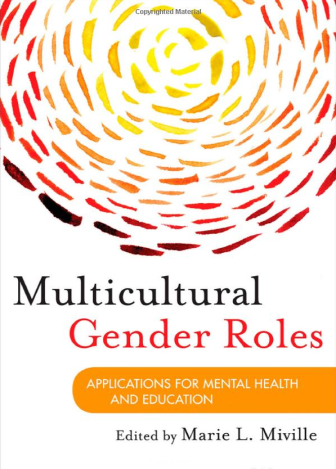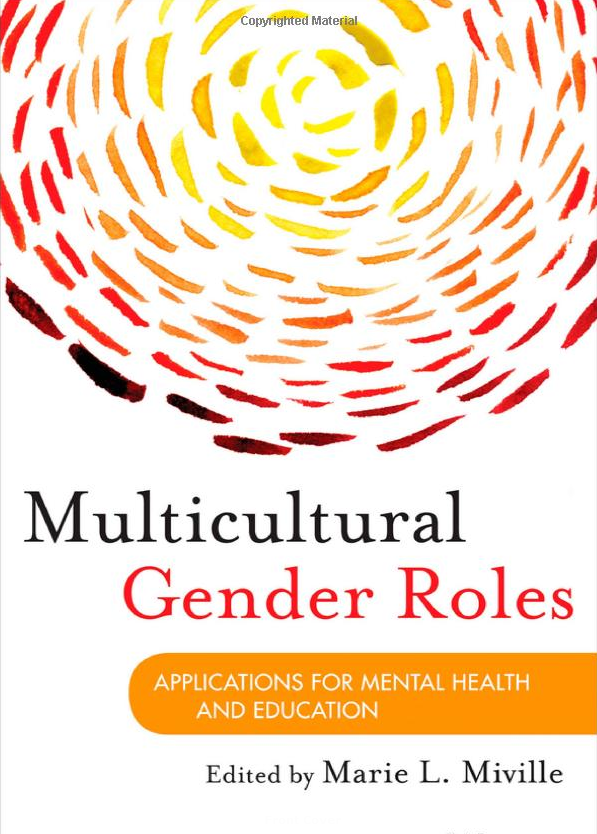 Multicultural Gender Roles: Applications for Mental Health and Education
Multicultural Gender Roles: Applications for Mental Health and Education
Marie L. Miville, Editor
Wiley, 2013
283 Pages
By Gail Bush
“You know, it’s just like we’re given these roles,” exclaims a young black woman bemoaning the paralyzing burden of tradition weighing heavily on her 21st century sensibilities.
Some cultural norms simply seem insurmountable, unchanging and unyielding. Young adults of color report feeling double the whammy from both race and gender, that each gender within their ethnicity or race has specific standards of behavior within the family, the community and society.
Dr. Marie Miville, a professor in the department of counseling and clinical psychology at Columbia University, and her colleagues state that the goal of “Multicultural Gender Roles” is to explore the impact of race and ethnicity on gender roles. Through discussions with study participants, they reveal multiple sources of these messages and the ways that racial and ethnic minority youth negotiate those expectations.
Subsequent to their research, Dr. Miville et al. identify patterns of behavior that challenge traditional gender roles. The authors provide recommendations for youth workers to increment change as their charges enter adulthood. The specific objective of their research is negotiating gender roles, to lift the weight of stultifying expectations and limitations. The value of this research is the wide range of possible strategies that might resonate with youth struggling with identity in any subculture. Youth workers learn about strategies effectively used by individuals of color that include: “resolving conflicts; navigating privilege and oppression; understanding one’s impact on others; transforming self-perceptions; intersecting identities; navigating emotions; constructing their own gender styles/expressions; and constructing their roles in family, community, and society.” The authors focus on gender roles among young adult African-Americans, Latino/as, and Asian-Americans.
Study participants openly share challenges and their personal experiences. Gendered racism is defined as “ways that racist and sexist attitudes, beliefs, and discriminatory behavior can be intertwined into a single phenomenon.” Conversely, it is natural for humans to develop through adolescence seeking equality, understanding of, and acceptance for the multi-faceted young adults who they are in the process of becoming. Those who have been raised with strong family values seek to hold onto traditional cultural beliefs without losing their individuality. “Multicultural Gender Roles” includes many examples of participants’ transcripts that could serve youth workers as conversation prompts for individual or group discussions. Additionally, the Gender Role Interview Guide, a succinct nine-item questionnaire, could be useful for clinical and non-clinical programming purposes including gender role exploration and discussion.
Each participant’s voice is distinctive, persuasive and heartfelt. Anyone trained in service to youth will be touched by the raw emotion behind the words. For example, Latino participants descriptively define the deep-rooted concept of machismo:
“My father taught me to be masculine. And he taught me to be a fighter, don’t give up. When somebody comes at you, push you, don’t take it. Hit ‘em back. He taught me to don’t care who it is, where he’s coming from, how big it is. You hit. And you hit. And you hit.”
While machismo is a commonly understood Latino gender attribution, Latinas confide that they struggle with the lesser known “Maria Paradox,” which traditionally balances the gender roles: “Submissive, passive, receptive, tolerant, uh beautiful and has to be her … main concern, raising the children.”
“You’re supposed to be a superwoman. … When I do get married, then I’m supposed to be everything. That’s the key, the magic door that unlocks my whole universe to be superwoman. I can’t be superwoman if I don’t have a husband.”
African-American female participants candidly share outlooks from “the bottom of the ladder.”
“There was a book that I was reading in fifth grade that was about this young black girl who wanted to fight in the Civil War and in order to be able to do it she had to dress like a boy. And I think it was in the dialogue, she’s talking about being a slave and being, being a child, so being under every adult; being a slave and so being under every white person; being a girl, and so being under every male. And that she was the very, very, very bottom of the ladder. . . . And I remember sitting there thinking that that was me, that I was, as a child, I had no power; as a woman I had no power; and as a Black person, I had no power.”
Young African-American males take cues from their fathers — those present, absent or occasionally present. One participant explains: “He just knew when to take charge when he had to. Now, when I say my father contributed to my masculinity is, yes, when he was around, he took care of things and was very dominant and compassionate, yes, but still he took care of things and that’s what a man is supposed to do, quote-unquote, in today’s world. But where it really contributes to my views as I got older and I came into my own conclusion as a masculine man is because the operative word was when he was around. …”
Dr. Miville and colleagues expose that our racial-ethnic identity greatly impacts how we experience gender. Expectations, expressions and presentation regarding gender begin at birth and continue to be communicated throughout childhood and young adulthood. Family, community and society through media all factor into relaying these traditional gendered and racially-ethnically specific messages. The model developed for negotiating gender roles offers life lessons of acknowledgement, adaptation and acceptance. The very act of discussing gender roles, as these researchers did with their study participants, fosters a mindful approach to self-awareness.
“Multicultural Gender Roles” is recommended for youth workers who serve diverse populations and engage in issues of gender roles. Discussion points modeled throughout the study confirm the very sanguine conclusion that there is no one right negotiation of gender role, but rather that we each must find, or make, the path that suits us best.































